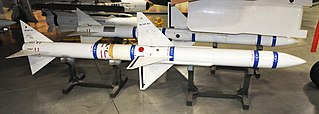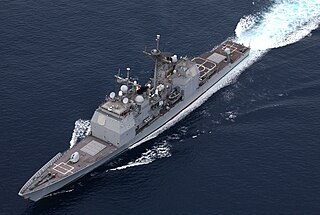
The AIM-7 Sparrow is an American medium-range semi-active radar homing air-to-air missile operated by the United States Air Force, United States Navy, United States Marine Corps, and various other air forces and navies. Sparrow and its derivatives were the West's principal beyond visual range (BVR) air-to-air missile from the late 1950s until the 1990s. It remains in service, although it is being phased out in aviation applications in favor of the more advanced AIM-120 AMRAAM.

The AGM-88 HARM is a tactical, air-to-surface anti-radiation missile designed to home in on electronic transmissions coming from surface-to-air radar systems. It was originally developed by Texas Instruments as a replacement for the AGM-45 Shrike and AGM-78 Standard ARM system. Production was later taken over by Raytheon Corporation when it purchased the defense production business of Texas Instruments.

The TomahawkLand Attack Missile (TLAM) is a long-range, all-weather, jet-powered, subsonic cruise missile that is primarily used by the United States Navy and Royal Navy in ship and submarine-based land-attack operations.

The Aegis Combat System is an American integrated naval weapons system, which uses computers and radars to track and guide weapons to destroy enemy targets. It was developed by the Missile and Surface Radar Division of RCA, and it is now produced by Lockheed Martin.

The Raytheon Company was a major U.S. defense contractor and industrial corporation with manufacturing concentrations in weapons and military and commercial electronics. It was previously involved in corporate and special-mission aircraft until early 2007. Raytheon was the world's largest producer of guided missiles. In April 2020, the Raytheon Company merged with United Technologies Corporation to form Raytheon Technologies, which changed its name to RTX Corporation in July 2023.

The RIM-7 Sea Sparrow is a U.S. ship-borne short-range anti-aircraft and anti-missile weapon system, primarily intended for defense against anti-ship missiles. The system was developed in the early 1960s from the AIM-7 Sparrow air-to-air missile as a lightweight "point-defense" weapon that could be retrofitted to existing ships as quickly as possible, often in place of existing gun-based anti-aircraft weapons. In this incarnation, it was a very simple system guided by a manually aimed radar illuminator.

The Halifax-class frigate, also referred to as the City class, is a class of multi-role patrol frigates that have served the Royal Canadian Navy since 1992. The class is the outcome of the Canadian Patrol Frigate Project, which dates to the mid-1970s. HMCS Halifax was the first of an eventual twelve Canadian-designed and Canadian-built vessels which combine traditional anti-submarine capabilities with systems to deal with surface and air threats as well. Ships of the class are named after capital cities of Canadian provinces, the capital of Canada, Ottawa, and the major cities of Calgary, Montreal, and Vancouver.

The RIM-116 Rolling Airframe Missile (RAM) is a small, lightweight, infrared homing surface-to-air missile in use by the German, Japanese, Greek, Turkish, South Korean, Saudi Arabian, Egyptian, Mexican, UAE, and United States navies. It was originally intended and used primarily as a point-defense weapon against anti-ship missiles. As its name indicates, RAM rolls as it flies. The missile must roll during flight because the RF tracking system uses a two-antenna interferometer that can measure phase interference of the electromagnetic wave in one plane only. The rolling interferometer permits the antennas to look at all planes of incoming energy. In addition, because the missile rolls, only one pair of steering canards is required. As of 2005, it is the only U.S. Navy missile to operate in this manner.

An anti-radiation missile (ARM) is a missile designed to detect and home in on an enemy radio emission source. Typically, these are designed for use against an enemy radar, although jammers and even radios used for communications can also be targeted in this manner.

Active radar homing (ARH) is a missile guidance method in which a missile contains a radar transceiver and the electronics necessary for it to find and track its target autonomously. The NATO brevity code for an air-to-air active radar homing missile launch is fox three.

The four De Zeven Provinciën-class frigates are air-defence and command frigates in service with the Royal Netherlands Navy. This class of ships is also known as "LCF". The ships are similar to the German Sachsen-class frigates in role and mission.

The RIM-66 Standard MR (SM-1MR/SM-2MR) is a medium-range surface-to-air missile (SAM), with a secondary role as an anti-ship missile, developed for the United States Navy (USN). A member of the Standard Missile family of weapons, the SM-1 was developed as a replacement for the RIM-2 Terrier and RIM-24 Tartar that were deployed in the 1950s on a variety of USN ships. The RIM-67 Standard (SM-1ER/SM-2ER) is an extended range version of this missile with a solid rocket booster stage.

The RIM-174 Standard Extended Range Active Missile (ERAM), or Standard Missile 6 (SM-6), is a missile in current production for the United States Navy. It was designed for extended-range anti-air warfare (ER-AAW) purposes, providing capability against fixed and rotary-wing aircraft, unmanned aerial vehicles, anti-ship cruise missiles in flight, both over sea and land, and terminal ballistic missile defense. It can also be used as a high-speed anti-ship missile. The missile uses the airframe of the earlier SM-2ER Block IV (RIM-156A) missile, adding the active radar homing seeker from the AIM-120C AMRAAM in place of the semi-active seeker of the previous design. This will improve the capability of the Standard missile against highly agile targets and targets beyond the effective range of the launching vessels' target illumination radars. Initial operating capability was planned for 2013 and was achieved on 27 November 2013. The SM-6 is not meant to replace the SM-2 series of missiles but will serve alongside and provide extended range and increased firepower. It was approved for export in January 2017.

The Operational Test and Evaluation Force (OPTEVFOR) is an independent and objective agency within the United States Navy for the operational testing and evaluation (OT&E) of naval aviation, surface warfare, submarine warfare, C4I, cryptologic, and space systems in support Navy and Department of Defense acquisition programs.

The AIM-9 Sidewinder is a short-range air-to-air missile. Entering service with the United States Navy in 1956 and the Air Force in 1964, the AIM-9 is one of the oldest, cheapest, and most successful air-to-air missiles. Its latest variants remain standard equipment in most Western-aligned air forces. The Soviet K-13, a reverse-engineered copy of the AIM-9B, was also widely adopted.
RIM-101 was a short-lived project by the United States Navy to develop a surface-to-air missile (SAM) for the defense of naval vessels. Developed during the early 1970s, the project, possibly derived from the RIM-7 Sea Sparrow, was cancelled before the start of detailed design work.

RTX Corporation, formerly Raytheon Technologies Corporation, is an American multinational aerospace and defense conglomerate headquartered in Arlington, Virginia. It is one of the largest aerospace and defense manufacturers in the world by revenue and market capitalization, as well as one of the largest providers of intelligence services. In 2023, the company's seat in Forbes Global 2000 was 79. RTX manufactures aircraft engines, avionics, aerostructures, cybersecurity solutions, guided missiles, air defense systems, satellites, and drones. The company is also a large military contractor, getting a significant portion of its revenue from the U.S. government.














